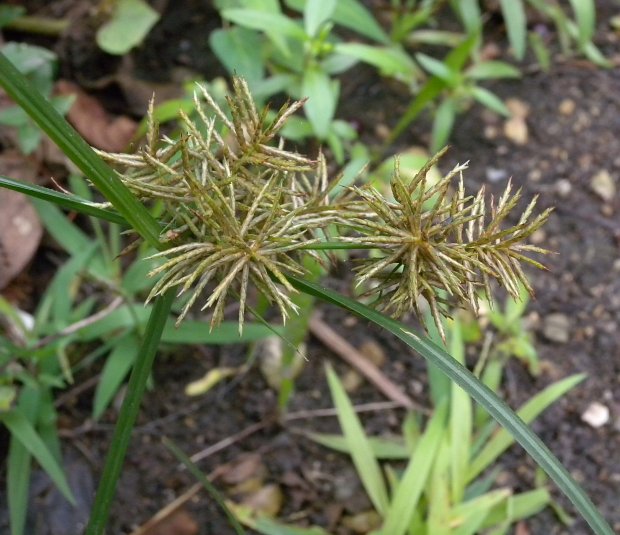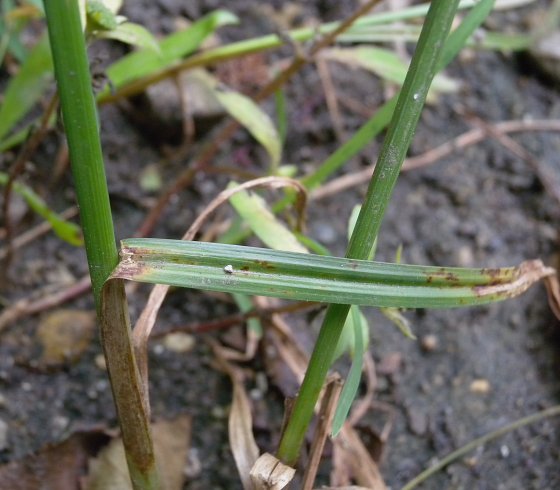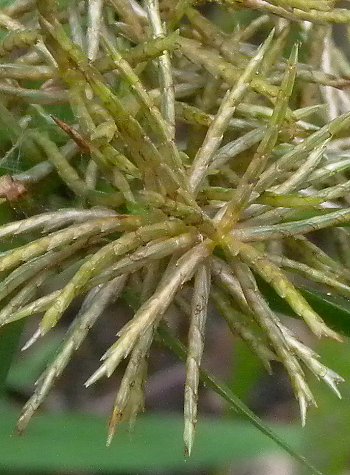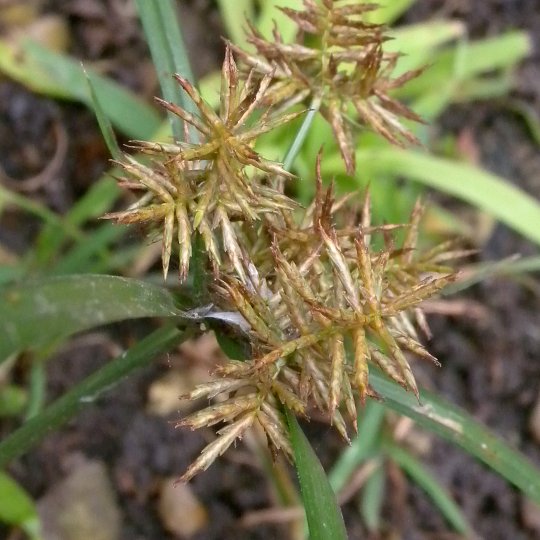Rusty Flatsedge
Cyperus odoratus
Sedge family (Cyperaceae)
Cyperus odoratus
Sedge family (Cyperaceae)
Description:
This sedge is a summer annual (in Illinois) that becomes 6–24" (15–60
cm.) tall. The culm is light to medium green, bluntly 3-angled, and
hairless.
There are usually 2–3 leaves along the lower one-third of the culm that
have ascending, arching, or widely spreading blades. The leaf blades
are 3–12" (7.5–30 cm.) long and 3–8 mm. across; they are longitudinally
furrowed and often shallowly M-shaped in cross-section. The upper blade
surface is light to medium green and hairless, while the lower blade
surface is
light grayish green or whitish green and often slightly glaucous. The
leaf sheaths are light to medium green and hairless, often turning
brown toward
the base of the plant. The culm terminates in a rather congested umbel
or compound umbel of floral spikes spanning up to 5" across and 4"
tall; there is a whorl of several leafy bracts underneath. There are
typically 1 or 2 sessile spikes and either solitary or clustered spikes
at the tips of 3–6 peduncles (floral stalks) up to 4" long; there are
typically 2–4 spikes per cluster. The peduncles are are ascending to
erect, straight, light to medium green, and hairless.

Individual spikes are ½–1½" (12.5–37.5 mm.) long with a short-cylindrical shape, resembling bottle brushes from the linear spikelets pointing in all directions. The color of the spikes varies primarily with the maturity of the scales of the spikelets; they are initially yellowish or whitish green, becoming yellowish or whitish brown, and finally reddish brown or deep brown at maturity. Individual spikelets are 7.5–12.5 mm. long, 1 mm. across, linear in shape, and terete but slightly flattened (subterete). The rachilla (central stalklet) of each spikelet is jointed and slightly zigzag. Each spikelet has 8–18 scales with perfect florets; the scales are slightly to moderately overlapping. Individual scales are about 2–2.5 mm. long, oblong-ovate, and convex along their green to brown central veins; their tips are somewhat acute and often mucronulate (tapering to very short narrow points). This latter characteristic can cause the lateral sides of the spikelets to appear slightly jagged. The lateral sides of the scales also have 1–3 fine longitudinal ribs (may require 10x magnification to see). The florets have 3 stamens and a tripartite style. The blooming period can occur from mid-summer to early autumn, lasting about 2–4 weeks for a colony of plants. The florets are cross-pollinated by the wind. Afterwards, they are replaced by achenes that 1–1.5 mm. long, oblongoid-ovoid in shape, and light brown to dark brown. The root system consists of fibrous roots (in Illinois). In more tropical areas, this sedge can be a short-lived perennial that occasionally produces short rhizomes.

Cultivation: The preference is partial to full sun, wet to moist conditions, and soil that is sandy, silty, or mucky. Most growth and development occurs during the summer. Individual plants can vary significantly in size depending on when the seeds germinate and growing conditions.
Range & Habitat: Rusty Flatsedge (Cyperus odoratus) is occasional to locally common throughout Illinois (see Distribution Map). It occurs in many areas of North America, South America, Africa, Australia, south Asia, and the Middle East. In Illinois, habitats include marshes, shorelines along ponds and rivers, openings in floodplain woodlands, sandbars, mudflats, margins of sloughs, prairie swales, damp areas along fields, roadside ditches, and meridians of highways. Areas with a history of disturbance are preferred. Rusty Flatsedge has some tolerance to the higher levels of salt along roadsides.

Faunal Associations: Insects that feed on Rusty Flatsedge (Cyperus odoratus) and other flatsedges (Cyperus spp.) include the larvae of Bactra verutana (Javelin Moth) and Spodoptera frugiperda (Fall Armyworm), larvae of Euphyes vestris (Dun Skipper), Ischnodemus rufipes (a chinch bug), Sphenophorus aequalis (Clay-colored Billbug) and other Sphenophorus spp. (billbugs), larvae of Plantella caudata (Sedge Gall Midge), Sipha flava (Yellow Sugar Cane Aphid) and other aphids, and Pseudococcus sorghiellus (Trochanter Mealybug) and other mealybugs (Frick & Wilson, 1978; Barlow & Kuhar, 2009; Wagner, 2005; Hoffman, 1996; Majka et al., 2007; Vaurie, 1983; Felt, 1917; Blackman & Eastop, 2013; ScaleNet website, 2014). The seeds of Rusty Flatsedge are an important food source for some ducks, including the Northern Pintail, American Wigeon, Green-winged Teal, and Mallard. Another waterfowl, the Canada Goose, feeds on the foliage (Havera, 1999). Other birds that eat the seeds of flatsedges include the American Tree Sparrow, Bobolink, Sora, Virginia Rail, and Wilson's Snipe (Martin et al., 1951/1961). Among mammals, Muskrats eat the culms of flatsedges to a minor extent (Hamerstrom & Blake, 1939). Their foliage is considered low-value browse to White-tailed Deer; it is also eaten by goats and cattle occasionally (Ramachandran & Soosairaj, 2014).
Photographic Location: A muddy shoreline along Crystal Lake in Urbana, Illinois. The photographed plant is the typical variety, Cyperus odoratus odoratus.

Comments: Another scientific name of this flatsedge is Cyperus ferruginescens, and another common name is Fragrant Flatsedge. Rusty Flatsedge (Cyperus odoratus) is another fairly common bottle brush flatsedge that prefers disturbed areas. It is distinct from many other flatsedges (Cyperus spp.) in Illinois by the tendency of the rachillas of its spikelets to break apart into segments to which the floral scales and achenes have been attached. Normally, the floral scales and achenes fall from their spikelets without the rachillas breaking apart into segments. Rusty Flatsedge has longer scales and achenes than Red-rooted Flatsedge (Cyperus erythrorhizos), but they are shorter than the scales and achenes of Straw-colored Flatsedge (Cyperus strigosus). Another difference is that the spikelets of Rusty Flatsedge are more terete in cross-section than the spikelets of other flatsedges, which are usually more flattened. Across its worldwide distribution, Rusty Flatsedge is rather variable in its appearance. In particular, the extent to which its scales overlap each other along the spikelets can vary. For the typical variety of this plant, Cyperus odoratus odoratus, the scales moderately overlap each other, while for Cyperus odoratus englemannii, the scales barely overlap each other. Both of these varieties can be found in Illinois; some authors prefer to categorize them as distinct species.

Individual spikes are ½–1½" (12.5–37.5 mm.) long with a short-cylindrical shape, resembling bottle brushes from the linear spikelets pointing in all directions. The color of the spikes varies primarily with the maturity of the scales of the spikelets; they are initially yellowish or whitish green, becoming yellowish or whitish brown, and finally reddish brown or deep brown at maturity. Individual spikelets are 7.5–12.5 mm. long, 1 mm. across, linear in shape, and terete but slightly flattened (subterete). The rachilla (central stalklet) of each spikelet is jointed and slightly zigzag. Each spikelet has 8–18 scales with perfect florets; the scales are slightly to moderately overlapping. Individual scales are about 2–2.5 mm. long, oblong-ovate, and convex along their green to brown central veins; their tips are somewhat acute and often mucronulate (tapering to very short narrow points). This latter characteristic can cause the lateral sides of the spikelets to appear slightly jagged. The lateral sides of the scales also have 1–3 fine longitudinal ribs (may require 10x magnification to see). The florets have 3 stamens and a tripartite style. The blooming period can occur from mid-summer to early autumn, lasting about 2–4 weeks for a colony of plants. The florets are cross-pollinated by the wind. Afterwards, they are replaced by achenes that 1–1.5 mm. long, oblongoid-ovoid in shape, and light brown to dark brown. The root system consists of fibrous roots (in Illinois). In more tropical areas, this sedge can be a short-lived perennial that occasionally produces short rhizomes.

Cultivation: The preference is partial to full sun, wet to moist conditions, and soil that is sandy, silty, or mucky. Most growth and development occurs during the summer. Individual plants can vary significantly in size depending on when the seeds germinate and growing conditions.
Range & Habitat: Rusty Flatsedge (Cyperus odoratus) is occasional to locally common throughout Illinois (see Distribution Map). It occurs in many areas of North America, South America, Africa, Australia, south Asia, and the Middle East. In Illinois, habitats include marshes, shorelines along ponds and rivers, openings in floodplain woodlands, sandbars, mudflats, margins of sloughs, prairie swales, damp areas along fields, roadside ditches, and meridians of highways. Areas with a history of disturbance are preferred. Rusty Flatsedge has some tolerance to the higher levels of salt along roadsides.

Faunal Associations: Insects that feed on Rusty Flatsedge (Cyperus odoratus) and other flatsedges (Cyperus spp.) include the larvae of Bactra verutana (Javelin Moth) and Spodoptera frugiperda (Fall Armyworm), larvae of Euphyes vestris (Dun Skipper), Ischnodemus rufipes (a chinch bug), Sphenophorus aequalis (Clay-colored Billbug) and other Sphenophorus spp. (billbugs), larvae of Plantella caudata (Sedge Gall Midge), Sipha flava (Yellow Sugar Cane Aphid) and other aphids, and Pseudococcus sorghiellus (Trochanter Mealybug) and other mealybugs (Frick & Wilson, 1978; Barlow & Kuhar, 2009; Wagner, 2005; Hoffman, 1996; Majka et al., 2007; Vaurie, 1983; Felt, 1917; Blackman & Eastop, 2013; ScaleNet website, 2014). The seeds of Rusty Flatsedge are an important food source for some ducks, including the Northern Pintail, American Wigeon, Green-winged Teal, and Mallard. Another waterfowl, the Canada Goose, feeds on the foliage (Havera, 1999). Other birds that eat the seeds of flatsedges include the American Tree Sparrow, Bobolink, Sora, Virginia Rail, and Wilson's Snipe (Martin et al., 1951/1961). Among mammals, Muskrats eat the culms of flatsedges to a minor extent (Hamerstrom & Blake, 1939). Their foliage is considered low-value browse to White-tailed Deer; it is also eaten by goats and cattle occasionally (Ramachandran & Soosairaj, 2014).
Photographic Location: A muddy shoreline along Crystal Lake in Urbana, Illinois. The photographed plant is the typical variety, Cyperus odoratus odoratus.

Comments: Another scientific name of this flatsedge is Cyperus ferruginescens, and another common name is Fragrant Flatsedge. Rusty Flatsedge (Cyperus odoratus) is another fairly common bottle brush flatsedge that prefers disturbed areas. It is distinct from many other flatsedges (Cyperus spp.) in Illinois by the tendency of the rachillas of its spikelets to break apart into segments to which the floral scales and achenes have been attached. Normally, the floral scales and achenes fall from their spikelets without the rachillas breaking apart into segments. Rusty Flatsedge has longer scales and achenes than Red-rooted Flatsedge (Cyperus erythrorhizos), but they are shorter than the scales and achenes of Straw-colored Flatsedge (Cyperus strigosus). Another difference is that the spikelets of Rusty Flatsedge are more terete in cross-section than the spikelets of other flatsedges, which are usually more flattened. Across its worldwide distribution, Rusty Flatsedge is rather variable in its appearance. In particular, the extent to which its scales overlap each other along the spikelets can vary. For the typical variety of this plant, Cyperus odoratus odoratus, the scales moderately overlap each other, while for Cyperus odoratus englemannii, the scales barely overlap each other. Both of these varieties can be found in Illinois; some authors prefer to categorize them as distinct species.